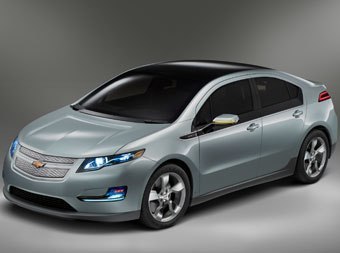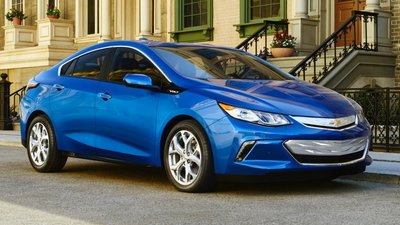Chevrolet Stops 2015 Volt Production - Gets Ready To Build 2016 Model
 2011, 2012, 2013, 2014, 2015 First Gen Chevrolet Volt |
More Than You Want To Know: 6548 Chevrolet Volt Articles, Reviews, News, Specs, Comparisons
Detroit Michigan April 10, 2015; No the sky is not falling (yet?) on Chevrolet's breakthrough unique and practical extended range EV (EREV).
Chevrolet said that sales of the 2015 Volt are slow with only 1,874 have been sold through the first quarter, down 48% from a year ago, so instead of increasing inventory it will begin its 2016 model year retooling months early.
Commenting on the news from Chevrolet are "experts from KBB:
From Akshay Anand, analyst at Kelley Blue Book’s KBB.com: “Halting Chevrolet Volt production in anticipation of the all-new 2016 model year is a smart move for GM, and allows for less inventory and incentives on the outgoing model. Hybrid and alternative fuel vehicle sales have been declining for some time now, with gas prices well below the summer prices of 2014. Sales of the Volt are down nearly 50 percent for the first quarter this year, as consumers are already anticipating the new 2016 Volt, which has more aggressive styling, more premium interior, and seating for five.”
From Eric Ibara, director of residual values for Kelley Blue Book’s KBB.com: “It’s hard to conclude that the softness in Volt sales this year is a reflection on the weakness of the product. Once Chevrolet announced that the 2016 Volt will have an increased range of 50 miles, it made sense for potential buyers to wait a few months to get the new, improved version. The low gas prices are not helping any of the EV sales, but we need to wait for the launch of the new Volt to gauge its long-term prospects.”
From Michelle Krebs, senior analyst at Autotrader: “Honda announced it is moving production of its Honda Accord Hybrid from Ohio to Japan, and now General Motors says it is cutting Chevrolet Volt production due to rising inventories. Both announcements indicate weakness of hybrid sales. Autotrader’s analysis of IHS/Polk registration data shows the hybrid/electric vehicle share of vehicle registrations peaked in May 2014, and that share has dropped every month since then. And don’t blame low gas prices. Share of the market began trending downward when gas prices were still increasing, and continued to decline with gas prices above or near the $3.50 gallon mark. In fact, the share declines for four consecutive months from May to September 2014 when gas prices were near historically high levels. Further, that was against the backdrop of strong total vehicle sales and a flurry of new hybrid and EV introductions.”
The all-new 2016 Volt was shown in January at the North American International Auto Show in Detroit with stronger styling and more interior room. GM also showed the Chevrolet Bolt concept which is an all-electric car designed to go 200 miles on a single charge, plus other changes;
Chevrolet News Release - 2016 Chevrolet Volt Delivers More
DETROIT – The all-new Voltec extended range electric vehicle (EREV) propulsion system will continue to be the powerhouse providing Volt’s electric-driving experience. Owners should be able to drive more than 1,000 miles on average between gasoline fill-ups with a total estimated driving range exceeding 400 miles, 50 of those in all-electric mode.
Featuring a new, 192-cell/18.4-kWh lithium-ion battery pack and new, 111-kW two-motor drive unit, the Voltec system is up to 12 percent more efficient and approximately 100 pounds (45 kg) lighter than the previous system. It also goes from 0-60 in 8.4 seconds.
“The improvements in the efficiency and performance of the 2016 Volt are driven by what owners said they wanted in the next-generation model: more range, better fuel economy and stronger acceleration,” said Andrew Farah, vehicle chief engineer. “Building on General Motors’’ industry leading battery and drive-unit technologies, we’ve delivered all of that, while also making the Volt more refined and fun to drive.”
Practically every element and component of the Voltec system, which includes the battery, drive unit, range-extending engine and power electronics, is new or improved. The Volt’s greater EV range and all new range-extender, result in a quieter driving experience.
“Volt remains the only electrically driven vehicle with range capability similar to traditional engine- or hybrid-driven cars of its size,” said Farah. “In all climates, it can be driven across town strictly on electricity or across the country with the assist of its range extender – a claim that can be made of no other electric vehicle without condition.”
Increased battery capacity
General Motors’ industry-leading battery technology includes
revised cell chemistry, developed in conjunction with LG Chem. Storage
capacity is 20 percent higher on a volume basis when compared to the
original cell, while the number of cells decreases from 288 to 192.
In short, the new Volt’s battery pack stores more energy – 18.4 kWh vs. the previous 17.1 kWh – with fewer cells, because there is more energy capacity per cell. It also has a more powerful discharge rate of 120 kW vs the previous 110 kW, which contributes to greater performance.
The battery pack retains the familiar T-shape of the first-generation Volt, but with revised dimensions. The new cells are layered in pairs in each cell group rather than the previous three-layer configuration. They are also positioned lower in the pack for improved (lower) center of gravity in the vehicle, and the overall mass of the pack decreases by more than 20.
“More energy with less weight is a win-win scenario for the Volt’s battery pack that helps the vehicle achieve its greater all-electric range,” said Bill Wallace, director of battery systems engineering. “Range, range and more range was the unambiguous message conveyed by current owners.”
The improved battery system continues to use the Volt’s industry-leading active thermal control system that helps maintains electric range.
Based on a GM study of more than 300 model year 2011 and 2012 Volts in service in California for more than 30 months, many owners are exceeding the EPA-rated label of 35 miles of EV range per full charge, with about 15 percent surpassing 40 miles of range. Current generation Volt owners have accumulated more than 600 million EV miles.
Two-motor drive unit
A new, two-motor drive unit is at the heart of the 2016 Volt’s
greater performance efficiency and expanded all-electric driving range. The
motors are smaller and lighter than the previous motor-generator drive
unit, while delivering more torque and power capability.
The new drive unit was also designed with improved noise and vibration characteristics that contribute to a quieter driving experience. Total motor mass reduction is more than 33 pounds (15 kg).
The motors can be used individually or in tandem, effectively delivering two torque paths to make the most of performance and efficiency. The new Volt can operate on a primary motor at lower speeds such as city driving, split power between the motors at moderate speeds or fully engage both motors for higher-load/higher-speed driving, such as passing on the highway. The Traction Power Inverter Module (TPIM), which manages power flow between the battery and the electric drive motors, has been built into the drive unit to reduce mass, and size, which contributes to greater efficiency.
“The blended arrangement of the two motors is a key contributor to the new Volt’s GM estimated 50-mile all-electric driving range,” said Larry Nitz, executive director of transmissions and electrification powertrain engineering. “The arrangement also enhances torque, giving the Volt a stronger feeling of acceleration and the ability to use both motors helps deliver nearly 20 percent improvement in low-speed electric acceleration.”
As with the first-generation model, the 2016 Volt offers four diving modes:
- Normal: Designed to make the most of battery range and efficiency during every day commuting.
- Sport: Provides revised accelerator pedal mapping for improved acceleration feel when passing or taking off from a stop.
- Mountain: Enables the engine and battery to combine power to achieve desired performance when traversing steep grades.
- Hold: Allows owners to use their battery power when they want to use it. Hold mode switches the Volt into extended-range operation, which is ideal for longer-distance highway driving.
The new drive unit will be manufactured at GM’s Powertrain plant in Warren, Mich.
New 1.5L range extender
A range-extending engine is the key feature that makes Volt a
no-compromises electric vehicle, providing owners the assurance they can go
anywhere, anytime without having to worry about whether they have enough
battery power to go through mountains or range for a spontaneous weekend
getaway.
Energy for extended-range operation comes from an all-new, high-efficiency 1.5L naturally aspirated four-cylinder engine, rated at 101 horsepower (75 kW). It features direct injection, a high-compression ratio of 12.5:1, cooled exhaust gas recirculation, wide authority cam phasers and a variable-displacement oil pump to make the most of performance and efficiency. It also features a lightweight aluminum block, compared to the current engine’s iron block.
The new range extender also runs on less-expensive regular unleaded fuel and delivers a GM-estimated combined fuel economy rating of 41 mpg. The 1.5L engine will be manufactured at GM’s Toluca, Mexico engine plant for the first year of production, then shift to the Flint, Mich. engine plant.



